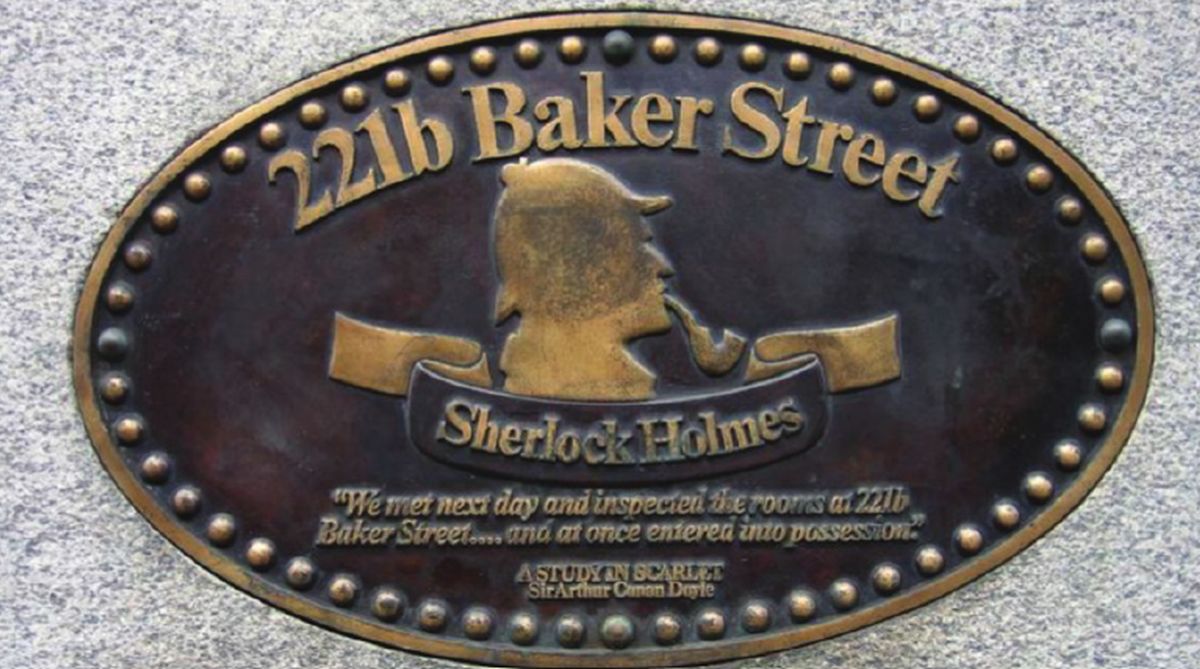Part I
It was a pleasant walk along a London street from Piccadilly Circus with one of my British friends, Anthony, in a summer evening of 2003. Suddenly I had to stop by the entrance of a station, my childhood nostalgia spooled out: “This is Charing Cross station! Sherlock Holmes used to board trains from here for some of his adventures outside London!”I exclaimed. Anthony was even more surprised at my excitement. He replied in a jovial tune: “Did he? Not a flight for long distance or a drive just outside London?”
Advertisement
Sherlock Holmes, one of the most adapted literary figures of all time, possibly “has enjoyed the most vigorous afterlife of any fictional character”. Arthur Conan Doyle published his first Sherlock Holmes story, A Study in Scarlet, 131 years ago in the perspective of late nineteenth century London.
However, Sherlock continues to intrigue us. Many old books might remain pleasant reading as period pieces, but certainly detective stories have additional drawbacks – they tend to become obsolete, at least to some people, unless their style and inherent technology are adjusted with time. Take a simple example.
Today’s Sherlock Holmes would never rush to his elder brother, Mycroft, for a simple piece of information only; the omniscient Google would certainly do a better job within a fraction of a second! Lots of other obvious changes — in transport system, dresses, style of talking, social outlook, political structure, types of weapons, and the plots and styles of crimes also are needed, possibly to a greater extent than most other types of novels.
Sherlock Holmes 2.0
The last decade might be one of the best time periods for the changing legacy of Sherlock Holmes which keeps growing thanks to two Guy Richie movies (2009, 2011) and two extraordinary TV series across two sides of the Atlantic. Video games, comic books, fan-created works, plus a potent Internet and social media presence add to this.
The 21st century Sherlock Holmes cannot remain as the same violin-playing, pipe-smoking, cocaine-injecting sleuth. Sherlock has been portrayed as hero as well as antihero in different adaptations, and he is described as tech-savvy, scientifically detached, even psychologically aberrant, romantically linked to women and also to Watson.
In Guy Ritchie’s blockbusters Sherlock Holmes (2009) and Sherlock Holmes: A Game of Shadows (2011) – Holmes turns into an action hero. However, both the films are set in Victorian London. Well, a 21st century modern Sherlock Holmes first appeared in 2010 BBC TV series Sherlock – with Steven Moffat and Mark Gatiss orchestrating the modernisation of the stories, the perspectives, and the classic characters of Sherlock Holmes, Dr. John Watson and Mrs. Hudson.
Subsequently its ‘Season 3’ has become the UK’s most watched drama series! Sherlock is blended with scientific analysis in an up-to-the-minute laboratory, with a nearly 30 years old all-new Sherlock Holmes, equipped with text messages, internet and GPS to solve crimes. Set in present-day London, the series feature a Victorian period fantasy resembling the original Holmes stories. Moffat had previous experience of adapting Robert Louis Stevenson’s Strange Case of Dr.Jekyll and Mr.Hyde for the 2007 BBC series Jekyll, while Gatiss had written the Dickensian Doctor Who episode The Unquiet Dead.
The Baker Street address and Holmes’ adversary Moriarty are kept intact as the integral parts of Holmes’ stories. Some insignificant changes were inevitable, e.g. Dr. Watson in the TV series has returned from military service in Afghanistan, while Conan Doyle’s original Watson was invalided home after serving in the Second Anglo-Afghan War (1878-80). Interestingly, though, Gatiss considered both, “The same unwinnable war”. Again, Sherlock Holmes and Dr. Watson of the TV series do not call each other ‘Holmes’ and ‘Watson’ as they did in Conan Doyle’s books; it has to be ‘Sherlock’ and ‘John’ in the perspective of today’s society.
Then it’s well known that Sherlock occasionally took cocaine and morphine to escape “the dull routine of existence”. It could be perfectly alright in the Victorian time period. But, what would happen to Sherlock Holmes 2.0 or beyond? Entertainment world certainly has a responsibility to the contemporary society too.
The BBC drama series, however, did not focus too heavily on the great detective’s drug abuse, although Sherlock fans were in shock as the detective got high on drugs and he smashed up his home in crazed rampage in an episode in early 2017. Holmes revealed that he was taking drugs again, much to the dismay of Watson and his fans.
Sherlock Holmes 2.1
Remarkable changes have been scripted in the Americanised modern Sherlock Holmes’ stories, Elementary, premiered on CBS in 2012, featuring a contemporary update of Sherlock Holmes.
The series, set in New York, of course has a clear statement against drug abuse – Holmes, a recovering drug addict and former consultant to Scotland Yard, relocates to Manhattan from London. Sherlock’s brilliance at solving cases is an essential part of the theme, and Dr. Watson would certainly be there in the stories, but interestingly as a female this time.
She is Dr. Joan Watson in this American adaptation, formerly a successful surgeon, and now hired by Sherlock’s wealthy father to help him in his rehabilitation as a sober companion. During the course of the series, she would become Holmes’ apprentice and then the partner in solving the cases.
And Professor James Moriarty, Holmes’ nemesis in Conan Doyle’s creation, is again depicted as a woman in this series – Jamie Moriarty; Holmes interrupted several of her plans when he was working for Scotland Yard. And due thrill and romance were induced in these stories as she tricked Sherlock into falling in love with her so that she could study him. She would have a great impact on Sherlock even after her arrest and imprisonment. Certainly such a ‘masala’ plot would have been beyond Conan Doyle’s imagination!
Part – II
Poirot 2.0 and Miss Marple 2.0
Sherlock Holmes certainly received new trademarks in the 21st century, so did the other legendary sleuths, at least to some extent. There has been continued yet changing presence and appeal of the Victorian detectives like Edgar Allan Poe’s Auguste Dupin and Charles Dickens’ Inspector Bucket.
Agatha Christie’s Hercule Poirot, the Belgian sleuth with the pointy moustache, distinctive mannerisms and the tendency to lapse into caricature in his enthusiasm to hunt down wrongdoers, could not escape the waves of modernisation either. Poirot also had to use laptop and a Palm Pilot to solve the mystery of the ‘Murder on the Orient Express’ during a train journey between Istanbul and Venice in a contemporary setting in its 2001 adaptation, while the original novel was written back in 1934.
When asked about his despise about computers, this modern-day Poirot replies: “I do. They are a poor substitute for the little grey cells of the brain but sometimes they can be surprisingly useful.” Admittedly this ‘usefulness’ of technology makes it inevitable and integral part of modern detective stories.
Then, what’s about Miss Marple 2.0? The 2004 ITV production The Body in the Library unveiled a ‘modern’ Miss Marple breaking her schoolmistress image. Miss Marple 2.0 is an open-minded woman who even has a lover lurking in her past.
The storyline was even modified with the change in the identity of the murderer. However, that might be an insignificant abartion of the story – there is a revolution through the introduction of a lesbian theme, which certainly could force many orthodox Christie fans to raise their eyebrows!
Feluda 2.0
Let’s have a look at the Indian detectives, say Sharadindu Bandyopadhyay’s Byomkesh Bakshi and Satyajit Roy’s Feluda – two popular sleuths of Bengali literature who even broke into the national entertainment arena. Do they also need to be equipped with modern technologies that most people use in their day-to-day lives?
Interestingly Byomkesh of the recent screen adaptations still lives in 1940s to early 1970s; and Feluda of the screen also roams within a decades-old Calcutta. Some minor uses of technology were seen although, e.g. in the movie version of Feluda’s adventure Badshahi Angti, it is seen that Bonobihari Babu used a modern digital voice recorder to record conversation between Feluda and Topshe.
Recently, however, Fuluda has been adapted as a twenty-first century modern sleuth in a TV series in Bangladesh. This Feluda is empowered with google, high-end android phone, Apple’s laptop. Feluda 2.0 goes to gym regularly, chats in Viber, connects through WhatsApp, races in car or motorbike, shoots from a running cab (much like James Bond!), surfs Wikipedia, calls Uber cabs. Apparently such a transformation to Feluda 2.0 was motivated by the BBC TV series ‘Sherlock’.
Feluda’s nemesis, Maghanlal, is also bound to change with time, as Professor Mariarty has significant transformation in ‘Sherlock’ or ‘Elementary’. Topshe, Feluda’s Watson, is a modern teenager – habituated to video-blogging, Facebook chatting, and of course he does not have much connection with books!
Do we need Mycroft Holmes anymore? What’s about the characters like Mycroft Holmes, Sherlock’s elder sibling, or Sidhu Jyatha (uncle) in Feluda’s stories? These characters were mostly used as the sources of information that are sometimes needed to solve the mysteries.
Well, are they at all relevant in the modern depiction of the legendary sleuths, when the ocean of information is just a click away in our laptop or mobile phone? Possibly their shelf life as information storage tool has expired with the advent of internet! However, the modernised versions of Sherlock Holmes could not get rid of Mycroft completely – maybe he had some additional appeals beyond just an Internet search engine.
In the TV series Sherlock, Sherlock’s relationship with Mycroft is possibly constructed based on the Holmes movie ‘Private Life of Sherlock Holmes’. Sherlock and Mycroft Holmes might have a turbulent relationship since their childhood; Sherlock is very egotistical and always sees Mycroft as an authoritative figure.
Mycroft Holmes in the American version Elementary worked as a restauranteur. In this series, Mycroft suffered from leukaemia and he had been estranged from Sherlock for years, due to Sherlock’s affair with his fiancé. Later Mycroft was looking forward to improving his relationship with Sherlock, but he died in July 2017.
Well, is that an indication of the future structure of Sherlock Holmes’ adaptations? Feluda 2.0, however, is still in touch with Sidhu Jyatha through WhatsApp! How Mycroft will evolve in future depictions, and will he (or even ‘she’ in future depictions, who knows!) finds a place in Sherlock 2.2 and beyond?
Sherlock Holmes 3.0
In most of the new adaptations, Sherlock got some sexual identity, which was missing in Conan Doyle’s creation. Is it again a 21st century trademark – Sherlock Holmes possibly cannot survive without such an identity? TV series Sherlock even transforms Sherlock a comical character to some extent, much to the amusement for the audiences – quite often due to the lack of his social skills and ignorance about other people’s emotions.
Certainly we don’t know how much transformation would feature to the Victorian sleuth in distant future. However, the animated TV series ‘Sherlock Holmes in the 22nd Century’ maybe an attempt to guess it. In New London, Inspector Beth Michael Maliani Lestrade of New Scotland Yard discovered a clone created from cells taken from the corpse of the 19th century criminal mastermind, Professor James Moriarty, whom Holmes had buried in a Swiss ice cave.
Lestrade then took the corpse of Holmes, preserved in the basement of New Scotland Yard, and biologist Sir Evan Hargreaves, who looks like Sir Arthur Conan Doyle, returned life and youth to Holmes’ body using his newly-invented cellular rejuvenation technique so that Holmes could combat Moriarty. Lestrade himself then acted as Dr. John Watson, and the Baker Street address comes into the perspective as well – all set in the 22nd century England. This certainly reduces to a crime thriller blended with science fiction!
Yes, I now understand why Anthony, my British friend, was astonished at my excitement on Sherlock Holmes originating journeys from the Charing Cross station. Sherlock certainly needs to adapt – continuously, with the changing lifestyles, technologies, social customs, norms and values, romance, and he should redefine his lifestyle and habits as well!
All that we need is a seamless transformation from a Victorian Sherlock Holmes to Sherlock of modern time, and beyond. Let’s be prepared for bigger twists in future than just a female version of Watson or Moriarty, or even Holmes romancing with Moriarty.
Twenty-first century Sherlock is certainly not our grandfathers’ Sherlock Holmes! And the other fictional sleuths must also get out of their ‘period piece’ image, in order to prolong their shelf-life. However, the magic of 221B Baker Street is ‘timeless’ – that would certainly remain unchanged.
The writer is professor of statistics, Indian Statistical Institute, Kolkata.











